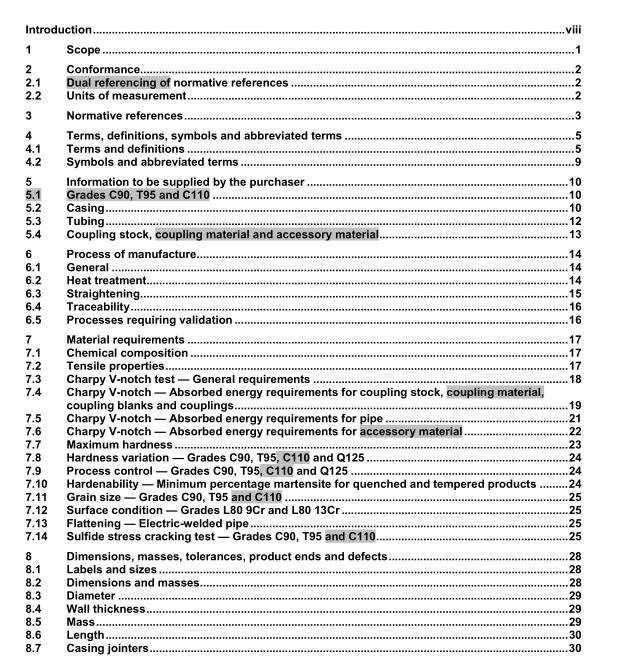API SPEC 5CT pdf download

API SPEC 5CT pdf download Specification for Casing and Tubing
6.2.2Group 1 (except H40)
For grades J55 and K55 products heat treatment is not mandatory. A heat treatment, consistent with Table C.3footnote b or Table E.3 footnote b, shall be applied if specified on the purchase agreement or may be applied atthe manufacturer’s option.
Grade N80 Type 1 product shall be normalised or, at the manufacturer’s option, shall be normalised and tempered.Grade N8oQ product shall be quenched and tempered.
Grade R95 shall be quenched and tempered.
Additional requirements for PSL-2 and PSL-3 products are specified in Annex H.
6.2.3Group 2
When requested by the purchaser, the manufacturer shall produce evidence to show that the tempering practicewill result in the pipe attaining the minimum tempering temperature.
Grade L80 13Cr may be subject to embrittlement when tempered below 620 C (1150 °F). When all productmeets the requirements in 7.3,7.4.5,7.5.3 and 10.7, no further precautions are necessary.
NOTE In this Standard when the symbol L80 is used alone it covers Grades L80 Type 1,L80 9Cr and L80 13Cr.
6.3Straightening
6.3.1Groups 1 (except Grade R95) and 3No specific methods are required.
Additional requirements for PSL-2 and PSL-3 products are specified in Annex H.6.3.2 Grade R95
Grade R95 product shall be subjected to no tensile or expansion cold-working, except that which is incidental tonormal straightening operations, and to no more than 3 % compressive cold-working, after the final temperingoperation.
Additional requirements for PSL-2 and PSL-3 products are specified in Annex H.
6.3.3Grades M65 and L80
Grades M65 and L80 shall not be subjected to cold working after the final heat treatment, except for that which isincidental to normal straightening operations. Grades M65 and L80 product rotary-straightened at temperaturesless than 480 °C (900 °F) shall not contain roll marks that exceed the maximum hardness specified in Table C.5or Table E.5; however:
roll marks that are not detectable by feel and have no measurable surface deformation are acceptablewithout further evaluation;
roll marks that are not more severe than those previously evaluated and verified by the manufacturer in adocumented procedure not to exceed the maximum hardness specified in Table C.5 or Table E.5 are acceptable without further evaluation;
― product with severe roll marks shall be either rejected or stress-relieved at 480 ºC (900 ºF) minimum.
6.3.4Grades c90 and T95
Grades C90 and T95 product may be subjected to cold rotary-straightening if, subsequent to the cold rotary-straightening operation,the pipe is heated to a minimum temperature of 480 c (9oo °F) for stress-relieving.When necessary, light gag-straightening for Grades C90 and T95 shall be permitted.
Additional requirements for PSL-2 and PSL-3 products are specified in Annex H.
6.3.5Grade C110
Product,when necessary,shall be either cold rotary straightened followed by stress relief at 30 °C to 55°C(50 °F to 100 °F) below the final specified tempering temperature,or hot rotary straightened with an exittemperature not more than 165 °C (300 °F) below the final specified tempering temperature. When necessary,light gag straightening shall be permitted.
6.3.6Grade Q125
Gag-press straightening or hot rotary-straightening at 400 °C(750 °F) minimum at the end of rotary-straighteningis acceptable (unless a higher minimum temperature is specified on the purchase agreement). lf hot rotary-straightening is not possible, the product may be cold rotary-straightened provided it is then stress-relieved at510 “c (950 °F) or higher. Product may be cold rotary-straightened without subsequent stress-relieving only byagreement between purchaser and manufacturer.
6.4Traceability
6.4.1General
The manufacturer shall establish and follow procedures for maintaining heat and/or lot identity until all requiredheat and/or lot tests are performed and conformance with specification requirements has been shown.
6.4.2Serialization of Grades c90,T95,C110 and Q125
The serial number shall be marked on products as specified below. lt is the responsibility of the manufacturer tomaintain the identification of material until it is received by the purchaser.
Each length of pipe shall be uniquely numbered so that test data can be related to individual lengths. In addition,when supplementary requirement A.7 SR12 is specified, the number shall identify the sequence in which thelengths were tempered in order to allow re-test in accordance with A.7.3 SR12.3.
Each length of coupling stock, coupling material, coupling blank, pup joint or accessory material shall be uniquelynumbered so that test data can be related to individual lengths. When cut from material that has been heat-treated full-body,full-length, the pieces shall be marked with the serial number of the ful-length piece.When heat-treated in coupling blank or individual lengths,each heat-treat lot (see 10.2.3) shall be uniquely numbered.Additionally, when coupling blanks, or pup joints or accessory material in individual lengths, are heat-treated as aunit in a continuous process-run, the pieces within the lot shall be sequentially numbered in the order in whichthey are heat-treated.









